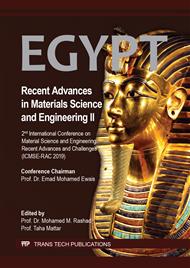[1]
I. Gordon, Y. Qiu, D. Van Gestel, J. Poortmans, Thin-film monocrystalline-silicon solar cells based on a seed layer approach with 11% efficiency, in Thin Film Solar Technology II conference, International Society for Optics and Photonics, 7771 (2010) 1-6.
DOI: 10.1117/12.860385
Google Scholar
[2]
M. A. Green, K. Emery, Y. Hishikawa, W. Warta, E. D. Dunlop, Solar cell efficiency tables (version 45), Progress in photovoltaics: research and applications, 23 (2015) 1-9.
DOI: 10.1002/pip.2573
Google Scholar
[3]
V. E. Ferry, M. A. Verschuuren, M. C.v. Lare, R. E. Schropp, H. A. Atwater, A. Polman, Optimized Spatial Correlations for Broadband Light Trapping Nanopatterns in High Efficiency Ultrathin Film a-Si:H Solar Cells, Nano Letter, 11 (2011) 4239-4245.
DOI: 10.1021/nl202226r
Google Scholar
[4]
S. Jeong, S. Wang, Y. Cui, Nanoscale photon management in silicon solar cells, Journal of Vacuum Science & Technology A: Vacuum, Surfaces, and Films, 30 (2012) 1-11.
DOI: 10.1116/1.4759260
Google Scholar
[5]
V. E. Ferry, M. A. Verschuuren, H. B. Li, E. Verhagen, R. J. Walters, R. E. Schropp, Light trapping in ultrathin plasmonic solar cells, Optics express, 18 (2010) A237-A245.
DOI: 10.1364/oe.18.00a237
Google Scholar
[6]
S. M. Sze, K.K. Ng, Physics of semiconductor devices, third ed., John wiley & sons, (2006).
Google Scholar
[7]
A. Shah, H. Schade, M. Vanecek, J. Meier, E. Vallat-Sauvain, N. Wyrsch, Thin film silicon solar cell technology, Progress in photovoltaics: Research and applications, 12 (2004) 113-142.
DOI: 10.1002/pip.533
Google Scholar
[8]
H. Park, D. Kim, J. Jung, D. P. Pham, A. H. Le, J. Cho, S. Q. Hussain, J. Yi, HF etched glass substrates for improved thin-film solar cells, Heliyon, 4 (2018) 1-17.
DOI: 10.1016/j.heliyon.2018.e00835
Google Scholar
[9]
J.J. Ji, Z. Shi, Texturing of glass by SiO2 film, U.S. patent 6,420,647. (2002).
Google Scholar
[10]
P. Campbell, Enhancement of absorption in silicon films using a pressed glass substrate texture, Glass technology, 43 (2002) 107-111.
Google Scholar
[11]
M. Ünal, H. Nasser, M. Günöven, İ. Sökmen, A. Tankut, R. Turan, Effect of aluminum thickness and etching time of aluminum induced texturing process on soda lime glass substrates for thin solar cell applications, physica status solidi (c), 12 (2015) 1201-1205.
DOI: 10.1002/pssc.201510125
Google Scholar
[12]
M. Lluscà, F. Urbain, V. Smirnov, A. Antony, J. Andreu, J. Bertomeu, Aluminum induced texturing of glass substrates with improved light management for thin film solar cells, Solar Energy Materials and Solar Cells, 147 (2016) 276-280.
DOI: 10.1016/j.solmat.2015.12.028
Google Scholar
[13]
A. Rayerfrancis, P.B. Bhargav, N. Ahmed, C. Balaji, G. Kumar, Glass surface etching with Aluminium-induced texture process for thin film solar cell applications, Materials Letters, 221 (2018) 305-308.
DOI: 10.1016/j.matlet.2018.03.154
Google Scholar
[14]
H. W. Deckman, J. H. Dunsmuir, Natural lithography, Applied Physics Letters, 41 (1982) 377-379.
DOI: 10.1063/1.93501
Google Scholar
[15]
M. Abdullah, M. Alghoul, H. Naser, N. Asim, S. Ahmadi, B. Yatim, K. Sopian, Research and development efforts on texturization to reduce the optical losses at front surface of silicon solar cell, Renewable and Sustainable Energy Reviews, 66 (2016) 380-398.
DOI: 10.1016/j.rser.2016.07.065
Google Scholar
[16]
M. L. Addonizio, L. Fusco, A. Antonaia, F. Cominale, I. Usatii, Optimization of surface morphology and scattering properties of TCO/AIT textured glass front electrode for thin film solar cells, Applied Surface Science, 357 )2015( 651-658.
DOI: 10.1016/j.apsusc.2015.09.073
Google Scholar
[17]
M. Ünal, Z. Demircioğlu, E. Dönerçark, E. Özkol, R. Turan, Aluminum induced texturing of sandy and prism glasses: Combination of micro/nano texture with macro texture, physica status solidi (a), 214 (2017) 1-6.
DOI: 10.1002/pssa.201600856
Google Scholar
[18]
O. Kluth, B. Rech, L. Houben, S. Wieder, G. Schope, C. Beneking, H. Wagner, A. Loffl, H. W. Schock, Texture etched ZnO:Al coated glass substrates for silicon based thin film solar cells, Thin Solid Films, 351 (1999) 247- 253.
DOI: 10.1016/s0040-6090(99)00085-1
Google Scholar
[19]
J. Müller, B. Rech, J. Springer, M. Vanecek, TCO and light trapping in silicon thin film solar cells, Solar energy, 77 (2004) 917-930.
DOI: 10.1016/j.solener.2004.03.015
Google Scholar
[20]
H. Cui, P. Gress, P. Campbell, M. Green, Developments in the aluminium induced texturing (AIT) glass process, Glass Technology-European Journal of Glass Science and Technology Part A, 53 (2012) 158-165.
Google Scholar


